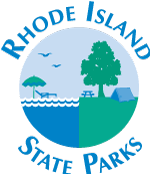East Matunuck State Beach History (1956)

The coastal plain that makes up the ocean front of the Rhode Island mainland begins in the northern reaches of the Town of Narragansett, stretches around and across Point Judith Neck, and flanks the Atlantic coast all the way to Watch Hill at Westerly. In its narrowest width at the north, it is less than a mile wide, and it widens out to three or four miles deep along the Atlantic rim. Its ocean fringe is ornamented by a watery lace of salt ponds, which are regularly washed by the sea and are home to a rich variety of marine life. The pierced-earring like ponds are fastened to the ocean by natural and man-made breach ways. Until the Town of Narragansett was set off on its own in 1901, a major portion of this coastline was in the Town of South Kingstown.
South Kingstown grew out of the pioneering settlements in the 17th century, known as the Pettaquamscutt Purchase. These scattered farms which benefited from the open expanse of the coastal plain did not really flourish until the Native American claims and the litigious strife of competing colonial land companies of Massachusetts, Connecticut, with Rhode Island were extinguished in the early 1700s.
Unlike the other English settlements in New England which were carved out of forests, the agricultural pursuits of the Rhode Island farmers were susceptible to pasturing flock and herd animals as opposed to crop fields. This direction led, in the words of one historian, “to an aristocracy of stock farmers and dairy men.” Although the term usually applied to the owners of these larger than usual estates was “The Narragansett Planters,” their operations acquired the aspect of sheep and cattle ranches. In particular, the area became noted for one of America’s first horse breeds, the Narragansett Pacer.
Many of the first families of this ‘planter class’ owed their origins to a practice by Newport merchant families of sending their younger offspring into this new country to establish extensive ‘farms’ that would produce marketable cargoes for the counting houses of Newport. The Newport influence in the rising coastal towns also provided political power to the merchant elites as their children often sent deputies to the Rhode Island General Assembly who supported the Newport position in colonial politics.
Following the end of the American Revolution, in the last decades of the 18th century however, the golden age of the Narragansett Planters began to wane. The Narragansett Pacer breed died out. Many of the large estates shrunk as the large families continued to subdivide their properties to provide inheritances. The large slave population that had made up the field hands on these properties were freed due to influences of the Quaker and Anglican reformers, and further slavery was abolished by the state. Many of these black folks migrated north seeking work on the docks of Providence, which by this time had replaced Newport as a center of shipping.
Economic activity in the early 19th century in the South County towns then shifted towards harnessing the swift-flowing interior streams to new milling technology. Peacedale and Wakefield developed along with a string of textile villages on both sides of the Pawcatuck River.
The other major change occurred by mid-19th century. That was the growing recognition of the possibility to use the very edges of the coastal plain for the surf and beach recreation. The idea of play and idleness had been counter to the Puritan and Dissenting theologies of the early settlers. Not until the 19th century were the physical health and positive psychological values of recreation acceptable to New England society. The idea of vacations and holiday relaxation gained popularity and social approval.
The leisure possibilities of the beach areas first appeared at Narragansett. As early as the 1780s, John Robinson had built a pier to facilitate the commercial activities of fishermen and farmers. By the mid 1840s, however, the steamboats arriving at Narragansett Pier were carrying people interested in availing themselves of the bathing and relaxation of the beach. Matunuck Beach appeared on a map of the area in 1857. A guide book of 1873 listed a hotel at Matunuck.
Twenty years later a “writer of pleasant places in Rhode Island” called Matunuck a popular place for Providence people, ‘more so, perhaps, than any other surf beach along the coast.’ A reporter, writing for newspaper in 1895, described a hotel at Matunuck that could accommodate 125 guests; it had been built in 1880, enlarged in 1884, and once again the year of his article. Along the beach that year, on a local map, there were bath houses. The writer of the newspaper article indicated, however, that the summer life was dull in comparison to Narragansett Pier, but provided rest and health. One of those local farmers who opened his house for summer visitors was George M. Browning. He called it the Ocean Star Cottage. His barn eventually morphed into the Theater-by-Sea, still in operation today.
In the last quarter of the 19th century, substantial summer houses began to appear back from the beach, along the Post Road and just beyond in an area, known as Matunuck Hills. Edward Everett Hale, who wrote, The Man Without a Country, and poems and ballads set in the Matunuck region, joined historian, William B. Weeden as notable summer residents. Boston area writers came, too. In the 20th century, the arrival of automobiles and improved paved roads led to a dense population of cottages and hotels at Matunuck Beach. Nearby Green Hill also developed at this time. A life-saving station opened here in 1912. Carpenter’s Beach began as a tent colony and then expanded to sea-side cottages.
From the Hurricane of ’38 through successive storms in 1954 and 1955, however, light-weight and well-built structures along this strand were from time to time swept away. Beginning in 1956 the State Department of Public Works began acquiring storm-ravaged land by public condemnation. Additional purchases by the state occurred in 1967, and the Division of Parks and Recreation, now in DEM, built a modern beach facility and took over the care and maintenance of the beach, totaling more than 144 acres. It is formally known as East Matunuck State Beach.
